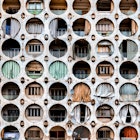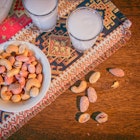

Start your Lebanese road trip in Beirut. Diego Fiore / Shutterstock
With just a week to spare in Lebanon, that tightly packed powerhouse of Middle Eastern history perched beside the Mediterranean, you can вҖ“ with the help of four trusty wheels вҖ“ embark on a road trip across some of the Middle East's most spectacular scenery, and to some of its most fascinating, friendly and off-the-beaten-track destinations.
Start: Beirut
Touch down in Beirut and hire a car. You will need to be a competent, unflustered driver to handle the Lebanese penchant for no-rules driving. Take it slow, but be prepared to hold your line in traffic; nobody is going to let you in unless you force the issue. Out of the driverвҖҷs seat, youвҖҷll find a magnificent welcome across the country.
Day 1: Saida and Tyre
Rather than going into the chaotic traffic of central Beirut, drive south along the coast to Saida (Sidon), an ancient Phoenician port city sporting a fine 13th-century Crusader sea castle, the magnificent Great Omari Mosque and a super-atmospheric souq. Wander the narrow lanes and stop in at the MusГ©e du Savon (Soap Museum) to see how the sudsy stuff is traditionally made, before continuing south to Tyre, whose ancient ruins, clean beaches and fine hotels make it a fascinating destination. The two principal archaeological sites include Byzantine streets, an immense funerary complex and a huge, well-preserved Roman hippodrome. Afterwards, dine out with locals on the Rue Abou Deeb or linger over seafood by the harbour. Spend the night in style at waterside Dar Alma or Asamina Boutique Hotel.

Day 2: Chouf Mountains
Retrace your steps to Saida and then turn inland, climbing into the Chouf Mountains. There are various gateways to the biosphere reserve that is home of many of LebanonвҖҷs famous cedars, but make for Maasser Al Chouf, where you can stroll on short trails among these magnificent trees in the cool, crisp mountain air. Head back down to explore lavish 19th-century Beiteddine Palace and the lovely village of Deir Al Qamar, near which is the lovely rural hotel of Beit Al Qamar.

Day 3: Baalbek
Hop back into the car and drive over a spectacular pass to reveal the glorious Bekaa Valley spread out beneath you. Follow the main road north to reach the ancient town of Baalbek, where the magnificently preserved Temple of Bacchus and the vast adjacent Temple of Jupiter hold their own against any Classical ruins in the whole Mediterranean. Baalbek is also headquarters of the Hezbollah party. You are unlikely, however, to see many traces; instead, check into the creaky old Palmyra Hotel where luminaries including Jean Cocteau and General de Gaulle once slept.

Day 4: BcharrГ© and the Qadisha Valley
Head west into the mountains again up spectacular hairpins to a pass (usually closed in winter), over the other side, where you'll find The Cedars, the countryвҖҷs most popular ski resort. Below here, pretty BcharrГ©, birthplace of legendary poet Khalil Gibran, is a fine lunch stop and gateway to the Qadisha Valley. This scenic gorge is dotted with ancient monasteries: hiking between them is the way to go if you have an extra day, though you should visit Deir Mar Elisha, the closest to town, even if you donвҖҷt.
Day 5: Tripoli
From the Qadisha, itвҖҷs an easy but steep descent down to the coast and LebanonвҖҷs principal northern city, Tripoli. The traditional Sunni old town has a superbly characterful souq, where stalls and shops occupy 14th- and 15th-century khans (travellersвҖҷ inns) and locals duck in and out of numerous historic madrassas (religious schools), hammams and mosques. Stay at Beit El Nessim or Via Mina in the seaside district of Al Mina and eat fresh fish at Silver Shore.

Day 6: Byblos
Head down the coastal highway, stopping in Byblos for a look at its seashore and archaeological site that covers everything from Neolithic remains to a Crusader castle via everything in between. Have lunch outside the site at marvellous Feniqia and make sure to check out the amazing fossils at MГ©moire du Temps. Staying the night here is worthwhile if you have extra time.
Day 7: Beirut
Expect heavy traffic as you drive from Byblos to the capital, but youвҖҷll be a dab hand at Lebanese driving by now. Leave the vehicle firmly parked in the hotel (or drop it off at the airport) while you explore Beirut's diverse districts. Stroll Downtown, extensively reconstructed following LebanonвҖҷs long, painful civil war; mingle with students and hipsters over shisha or craft beer in Hamra; stroll the seafront Corniche at sunset and hit Mar MikhaГ«l for a contemporary eating scene and the cityвҖҷs most vibrant selection of bars and clubs. Hit the rooftop at Junkyard and then take on the dance floor at subterranean B 018, watching BeirutвҖҷs beautiful people out to play and toasting the completion of a road trip with which few others back home will be able to compete.
Last updated June 2018
Explore related stories
![Photo/File #: 12MP ..Country: Great Britain..Site: Hurst Castle..Caption: 12MP aerial..Image Date: [November 2021?]..Photographer: ExploringWithin MUST CREDIT..Provenance: Watch 2022](https://lp-cms-production.imgix.net/2022-03/GBR%20Hurst%20Castle%20MUST%20CREDIT.JPG?w=780&h=425&fit=crop&auto=format&q=75)
Archaeology
25 heritage sites in danger, according to the World Monuments FundMar 2, 2022 вҖў 4 min read

 HistoryCheck out BeirutвҖҷs abandoned buildings captured in beautiful detail
HistoryCheck out BeirutвҖҷs abandoned buildings captured in beautiful detailFeb 7, 2020 вҖў 1 min read
 FoodAdventurous spirits: the best places to sample the worldвҖҷs most unusual alcohols
FoodAdventurous spirits: the best places to sample the worldвҖҷs most unusual alcoholsMay 9, 2019 вҖў 6 min read


 ArtDifferent brushstrokes: alternative artistic experiences in seven great cities
ArtDifferent brushstrokes: alternative artistic experiences in seven great citiesDec 13, 2018 вҖў 7 min read
 FoodThe best of Beirut nightlife: out late in the Middle East's original party city
FoodThe best of Beirut nightlife: out late in the Middle East's original party cityNov 16, 2018 вҖў 6 min read


![Photo/File #: 12MP ..Country: Great Britain..Site: Hurst Castle..Caption: 12MP aerial..Image Date: [November 2021?]..Photographer: ExploringWithin MUST CREDIT..Provenance: Watch 2022](https://lp-cms-production.imgix.net/2022-03/GBR%20Hurst%20Castle%20MUST%20CREDIT.JPG?w=730&h=630&fit=crop&auto=format&q=75)